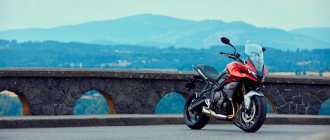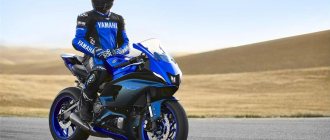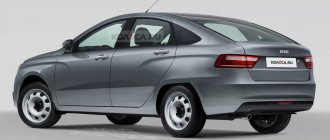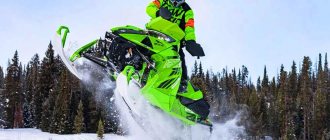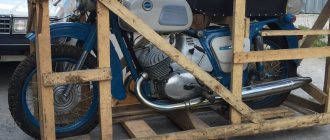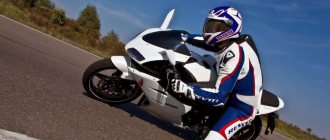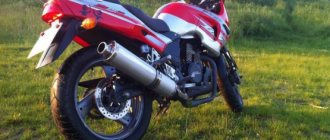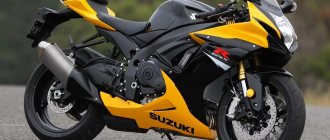KTM 1190 RC8
Who said that aspen trees won't produce oranges? Austrian engineers, who historically specialized in off-road vehicles, destroyed stereotypes by presenting their first sportbike to the world at the end of the 2000s.
Story
The appearance of a real ring device in the model line of a manufacturer specializing in off-road vehicles is illogical only at first glance. The slogan “Ready to race” and a flurry of sporting victories could not help but pull out: supermotos built on the basis of enduro, the first Duke roadsters, large touring enduros... KTM systematically captured more and more new market niches, so the appearance of the first prototypes of the ring apparatus at the beginning and the mid-2000s was natural.
Released in 2008, the sportbike was built from scratch, even the 1148 cc V-twin, installed in the traditional K-twin, was its own. Just a year later, the public was shown a modified device, primarily distinguished by an increased engine volume to 1195 “cubes”, front optics, wing and a wheelbase reduced by 10 mm, as well as the R version, which also featured wheels with Y-shaped spokes.
Already in 2011, the device underwent another wave of modifications that affected the engine, ignition system (with two spark plugs per cylinder), and also received different suspension settings. The R version completely replaced the “standard” one, and the main visual differences were the headlight with running lights and five-spoke wheels. In 2013, the motorcycle received a new slipper clutch.
And a year earlier, in 2012, the Track version also went on sale, distinguished by the absence of lighting equipment and already installed tuning from the factory catalog, thanks to which the engine power exceeded 180 “horses”. The evolution of the device, alas, did not go further: the current electronics - the “brain” of modern “sports” - never appeared on the RC8, and the Austrians ended its production in 2013, placing their bets on a new car. According to KTM President Stefan Pierer, the RC8 on the assembly line should replace the RC16, shown in the fall of 2015.
For what
Perhaps the KTM RC8 is the best compromise between the “wow factor” and the price: an exotic device is guaranteed to gather crowds around it, even if there is a superbike from Bologna next to it, while the cost of maintenance, as well as the original purchase, will be the same, otherwise and below. In addition, a rigid chassis, coupled with excellent suspension, brakes and a powerful twin engine will allow you to get great pleasure from driving around the city both at night and during the day, but it’s better to start your racing career on something else. Rare track days are the maximum an owner can count on: the loads that accompany serious and long races, coupled with additional tuning, are difficult for the vehicle’s engine to digest.
Choice
Alas, the RC8 can only be called successful from a technical point of view: both in the domestic and world markets, the motorcycle did not become a bestseller, remaining a toy for fans. That’s why it’s not easy to get reliable statistics on the “sores” that appear on a particular run. Nevertheless, problems, although small, have emerged. The device can hardly withstand racing use, so it is better to avoid cars in “blind” plastic during the phase, and owners of “stock” vehicles should be questioned with passion about the amount of time spent on the track. Found an RC8 that hasn't seen a ring? Great! Most likely, global problems will not arise, but he will have a couple of sore spots.
Firstly, you should listen carefully to the engine for ringing and clattering of valves - on these engines the clearances “leave” quite early, so you need to monitor them and, if necessary, adjust them every 8-10 thousand mileage. The “lost” gaps do not promise any serious problems, but when purchasing, it is better to bargain on the cost of adjustment, as well as shims.
Secondly, the standard release is quite heavy, so it is often replaced with the aftermarket “Akrapovich”. The latter weighs less and sounds more thoroughbred, but due to high temperatures and excessive vibrations, its pipes often burst at bends and welds, so any signs of depressurization should at least alert you. Vibrations, which are particularly aggravated in extreme conditions, cause the fasteners to become unscrewed and lost, so it is worth checking for their presence, and after purchasing, properly stretch and tighten them.
Thirdly, the RC8 gearbox lever is distinguished by its long stroke and opaque operation, requiring the pilot to get used to it and actively work with the left toe, but this is not so bad. The main thing is that the complex mechanism that transmits force from the gearbox lever to the shaft often fails: the rod breaks, so you need to carefully examine its condition, and also look for signs of repair.
In addition, early RC8s had weak gear selectors, which caused gears to slip out under load. The problem has been fixed on the RC8R, but it's still worth riding the bike before purchasing.
Fourthly, the pump seal often loses its seal, so if there are leaks on the drain hole of the pump, you should bargain a little and not refuse the purchase - there are no big problems with replacement, and the part is inexpensive.
Tuning
Despite not being very common, there are quite a lot of tuning for the RC8 on sale. There is everything on the market to turn the device into a racing car, and there are plenty of “nice things” for civilian use, such as high windshields and various sliders. In addition, the manufacturer itself offers an impressive catalog of factory and near-factory tuning at quite reasonable prices, so the first place to look is there.
Where to look
Alas, the choice is small: it was impossible to buy a new RC8 from our officials even last year, and dragging one from abroad is too expensive at the current exchange rate. That’s why all you have to do is look at online bulletin boards, where private traders consistently offer 3-4 vehicles, usually well-maintained and hung with various tunings
Test drive KTM1190 RC8
Many were eagerly awaiting the appearance of this motorcycle. This is not an updated model, this is the birth of a new motorcycle. Born to a parent who has never owned a sportbike. There is vast experience and world victories in motocross, there are very successful performances in the 250 cc class on the ring, but there has never been a superbike.
I wonder how it turned out?
Advertising slogan of the company K. This fully applies to motocross and enduro motorcycles. I bought a motorcycle at the dealership and tomorrow I can enter the race. Among road bikes, the race-ready Ducati is the “R” version. And we will definitely try to conduct a comparative test of these two motorcycles, yet Ducati has vast experience in building superbikes, and KTM has a great desire to be the best not only on off-road tracks, but also on circuits. But this will happen a little later, when Ducati will present its full model range in Ukraine. In the meantime, we have the opportunity to enjoy the latest “rising star” KTM RC8.
On the track
My acquaintance with the RC8 began at the Chaika circuit. The test drive was organized by the official importer of KTM in Ukraine, which appeared only this year, and everyone could try the new motorcycle. It is very appropriate that since the motorcycle is positioned as “ready to race”, it should be recognized on the race track. The very first lap forced me to stop and adjust the suspension. We reduced the rear spring preload and added rebound and compression force to the fork because the fork was a little soft for the track. And the motorcycle went. I went with extraordinary ease! When, sitting in front of the TV, you watch WSBK, where “liter” four-cylinder motorcycles race, and with them two-cylinder, 1200 cm3, you involuntarily think: “Where is motorcycle progress going?” Previously, motorcycles had engines of 125, 250, 350 cc, but now a “liter” is not enough for everyone!
Having tried the KTM RC8, you understand where to go. A motorcycle with an engine capacity of more than a liter steers so easily and dives into any turn so eagerly (even the slowest, on a karting track) that you involuntarily compare it with a “600”. But it’s not even six hundred, it feels different... The secret, in general, is simple. What prevents a rider from leaning the motorcycle quickly? Gyroscopes! Rotating at a speed of 15,000 rpm, the crankshaft of a liter engine weighing 10 kg is the same gyroscope that does not want its axis of rotation to be tilted. The wheels of a motorcycle are two more gyroscopes that prevent the motorcycle from tilting.
What could KTM engineers do about it? They created the most compact two-cylinder engine, with a crankshaft four times smaller than a Japanese liter! By their nature, “twos” are less revving, therefore, a lightweight crankshaft rotating at lower speeds means the gyroscopic effect of the engine is reduced many times over. What about the wheels? Proven solution: Marcesini wheels. It may not be the top-end model made of forged magnesium, but, nevertheless, it is Marcesini. The compact engine made it possible to make the chassis compact too. The "court supplier" of WP suspensions has developed a fork and shock absorber for the RC8 that you do not have to exchange for tuning ones. All these technical solutions, brought together under the orange plastic, allow you to drive even the slowest corner without touching the asphalt with your knee. Knowing the track, I allowed myself to go faster and faster with each lap: the motorcycle inspired confidence, and I wanted to enjoy the feeling of its weightlessness. What was “catchy” was his neutral behavior when turning: if you want to turn sharper, put it lower! If you want it even steeper, tilt it even lower. The chassis does not resist this at all. Exiting a turn looks like this: you add gas and the motorcycle, rising smoothly, accelerates out of the turn. But in slow corners it was difficult to dose the throttle due to the sharp response of the engine. At low speeds, the RC8 reacts very sharply to throttle input. But on a big track, at high speeds, this sharpness will disappear.
The brakes of the “newbie” are excellent! Without thinking twice, KTM used Brembo brakes. They are one hundred percent consistent with any sportbike, another thing is that not every manufacturer can afford to put them “in the base”. KTM probably can, and that's nice. It's nice when your thought controls the deceleration, and intermediaries in the form of levers, calipers, hoses bring it to the wheel without distortion. Braking before the next turn...you need to do it harder...even harder...and suddenly the rear wheel began to dance. One more lap, even faster, and now the rear is jumping before almost every turn. I stop and ask the KTM representative about the presence of a slipper clutch. Answer: it is not in the database. This is perhaps the only inappropriate saving that spoiled the impression, breaking the finished image of the ring motorcycle. The large-displacement twin-cylinder engine slows the bike so much that without a slipper clutch it is difficult to brake effectively when entering a corner.
It should be noted that in general, after riding on the track, I was left with a very enthusiastic impression. Never before has a motorcycle with such a big engine been so nimble. My inspired state could not be spoiled by various little things, such as, for example, an unreadable tachometer. But a very bright blinker signals that it’s time to change gear. The crash pad on the tank, installed “in the base,” hints that you will fall, and the manufacturer took care of the safety of the tank. It's kind of a trick that no one else has, but try hiding behind the fairing and keeping your elbows close to the tank. Crashpads get in the way. Ergonomic miscalculation? Maybe small. In a couple of days we will test the motorcycle in real city use, I think there will be new pros and cons.
In the city
It's a completely different experience. The unusual appearance of the motorcycle attracts the attention of drivers at traffic lights. Some will find the motorcycle beautiful, others will find it ugly, but no one will ever confuse it with any other. The landing is quite normal “sportbike”, you wouldn’t expect anything else. I even took a ride in the passenger seat: you sit high, in general, like in many modern “sports”. The muffler, hidden under the bottom of the motorcycle, not only visually, but also actually lightens the rear, while protecting the passenger’s legs from burns when boarding. The engine, with its smooth and confident thrust, is not “explosive”: the acceleration is powerful, but not breathtaking. There are also no provocations to driving too aggressively. The character of the engine is rather restrained, it seems to know what it was created for, it can respond with adequate acceleration in any situation, but it does not provoke hooliganism. But a sharp jerk when applying gas in the low speed zone is very annoying when driving in a traffic jam. I specifically noted that even if the “taffy” on the road moves at a speed of 20-25 km/h, then in order to stay in such traffic, you have to constantly “push” the clutch lever. Because it’s impossible to dose the gas: I opened it just a little, and the motorcycle was already jumping onto the crawling car in front. If you need to accelerate from idle, then in response to a slight turn of the knob, the engine becomes so noisy, rumbles and vibrates that you feel sorry for it. Only after 3 thousand revolutions does the engine return to normal mode. This behavior, in general, is not surprising for a forced engine with a volume of each cylinder of almost 600 cubic meters. The vibrations from the engine, which are transmitted throughout the motorcycle, create a somewhat rough feeling.
When driving at low speed (through courtyards, busy streets), both the operation of the throttle and the vibration are very annoying. The left hand gets tired of using the clutch, and the right hand catches fractions of a millimeter when turning the handle. The spring on the gas handle is very soft; when turning, you don’t feel any effort at all; it’s very difficult to dose it. I want to get out to an avenue as quickly as possible, along which I can navigate rather than “struggle” in a creeping stream. After all, it's a racing bike! A set of revolutions, intoxicating acceleration, which all motorcyclists love so much, and now the speedometer, the indicators of which are difficult to read on the dashboard among the many numbers, easily slips past the number “200”. There are no problems with the power and behavior of the motorcycle on smooth asphalt. But only on a perfectly smooth one! But we simply don’t have such roads. The rear suspension was so stiff for my weight that it seemed to transmit road conditions directly to my kidneys. The motorcycle remains stable on potholes, neither the steering wheel breaks out of your hands, nor the trajectory changes, it’s just very cowardly, and this is unpleasant.
Compared to this road bike, my race-ready circuit bike rides like a Mercedes. If you come across a broken road when leaving the yard, the shaking is involuntarily transferred to the “weightless” throttle, the engine jerks and the motorcycle jumps from engine jerks and potholes. You have to squeeze the clutch and roll. Extreme driving mode, but... “welcome to the Ukraine!” The pits are finally over. Acceleration is like an outlet; here the motorcycle is in its element. I stuck the first one in, then the paw up, the neutral light blinked for a moment and second gear went into gear, acceleration continued... One car pulled out, then a second one, I had to let off the gas. We figured out who was going where, we could go again, but the engine roared and the motorcycle was just rolling. I glance over the dashboard - the neutral is not on, I pull the paw up, the gear is engaged, the motorcycle starts moving.
There was a residue in my soul, somehow I had lost the habit of false neutrals and jumping gears on modern technology. In addition, it is simply dangerous both in the city and on the track. At that time, I had not yet read the tests in other magazines, I did not know the opinions of Western journalists who had already tried this motorcycle and everyone noted this problem with the gearbox. I rode and listened to how I felt on this motorcycle. Vibration! This is what is worse than a stiff suspension and a jerky engine at low speeds. You can reconfigure the suspension, change the spring, and drive only on a flat road. Driving at speeds above 3000 and then driving the engine is pleasant. But what to do with the vibration, which is present at any speed, it only changes the intensity and frequency, but after 10 minutes of driving the soles of the feet begin to itch. Unpleasant!
Photoshoot
We agreed to meet with the photographer. We need to take pictures of the motorcycle. There is a lot to photograph here. Each individual detail is the dream of many sportbike fans. Thoroughbred suspension and brakes. The instrument panel is multifunctional, like an on-board computer in cars. The most important button under the left thumb cuts off the lap time. The mirrors with built-in LED turn signals are both beautiful and easy to remove before heading out to the track.
While I was driving and thinking about how to photograph this motorcycle beautifully, turning over different options in my head, I still did not know that this motorcycle does not like to be photographed. After starting from the next traffic light, second gear did not engage. The box is stuck on the first one! Thoughts about the photo shoot immediately gave way to thoughts of “what could it be.” I am disappointed. Not only did the enthusiastic impression of this motorcycle after riding on the track change to the completely opposite in the city, but it also broke down. You can, of course, find some advantages in this. The result will be a full-fledged test, checking the operation of the branded warranty service.
It seems that while the KTM RC8 is being groomed as a winning weapon on the racetrack, its suitability for everyday use has taken a backseat. And to what level is reliability relegated then? Colin Chapman once said that a racing car should fall apart a meter after the finish line. If he travels more than a meter, it means you could have made him lighter; if he doesn’t reach the finish line, it means you overdid it in making him lighter.
From the editor:
It's not often that unusual incidents occur during a motorcycle test drive. But MotoDrive is objective and honest with its readers and does not write custom test materials (unlike many other publications), which is why we are loved by our readers and they trust us.
We became interested in how serious the breakdown was on the test KTM RC8 and, in order to inform you what happened AFTER, we contacted the general director of Moto-Point LLC, the official importer of the KTM brand. This is what he explained: “Most likely due to the fact that the motorcycle was not broken in properly, the retaining ring on the oil pump pressure reducing valve was cut off and its spring, jumping off its seat, got into the gear shift mechanism, as a result of which this mechanism jammed in 1st gear. After minor repairs, the engine's performance was restored to 100%. “The materials on this case have been transferred to the KTM plant for investigation.”
Text: Valery Garbaruk (three-time champion of Ukraine in ShKMG)
Photo: michel, Schedl R., Peuker H., Freeman G., Mitterbauer H.
Features of the KTM RC 8C 2022 sportbike:
- Limited edition of 100 units
- Hand built exclusively for track use
- 128hp, 140kg dry weight, power to weight ratio almost 1:1
- Custom designed racing exhaust with Akrapovic titanium muffler
- Custom designed racing air filter and airbox
- Custom 25CrMo4 chrome molybdenum steel tubular frame
- WP APEX PRO suspension components
- Racing braking components from Brembo
- Ultra-light Dymag aluminum wheels
The 2022 KTM RC 8C will be available for pre-order starting July 22.
KTM RC 8C buyers will also have the opportunity to join the Red Bull KTM Factory Racing test team in a unique 25-person event. On it, lucky winners will have the opportunity to ride with Dani Pedrosa and Mika Kallio, communicate with them and receive expert advice from them on the Circuito de Jerez track. Event participants will additionally receive a racing package of options, which will include:
- Additional set of rims
- Additional set of brake discs
- Front and rear tackles
- Tire warmers
- KTM Race mat
Sportbike KTM RC 8C 2022
The 2022 KTM RC 8C is a purpose-built lightweight racing prototype based on the renowned LC8c engine from the KTM 890 DUKE R and a custom-designed racing chassis equipped with high-quality racing components. Essentially, the KTM RC 8C allows the owner to own a bike that is as close to the racing equipment of a factory team as possible, without having to support that team itself.
Engine
Designed to be completely track-ready, the KTM RC 8C sportbike is built entirely by hand and features a high-torque stock engine for easy operation and maintenance. Beneath the lightweight GRP carbon composite body kit with Kevlar reinforcement, and based on the KTM RC16, lies a 128 hp, 889 cc, 8-valve, liquid-cooled, twin-overhead twin-cylinder, mounted in a custom-designed chrome-molybdenum steel tubular frame, complete with suspension components. WP Pro on both ends.
Sportbike KTM RC 8C
Suspension
At the front there is a 43mm WP APEX PRO 7543 fork with closed cartridges, made of high quality and lightweight materials. Developed from the experience gained from KTM's factory team racing in multiple international championships, the RC 8C front suspension is assembled by the same department that produces the KTM RC16 suspension, ensuring the best possible performance for both amateur and professional motorcycle racers. The fork has zero hydraulic travel limitation, which allows the rider to constantly control its shock-absorbing qualities.
The WP APEX PRO 7746 rear monoshock absorber with spring preload adjuster is responsible for the operation of the rear suspension and is easily adjusted to suit any height and weight, as well as to almost any situation thanks to separate fast and slow compression and rebound adjusters.
Sportbike KTM RC 8C
Sportbike KTM RC 8C - READY TO RACE
Every detail of this racing model is designed with track specifications in mind - from the quick release tank and body panels, to the lightweight Dymag wheels and racing slicks. Maximum braking performance is achieved using Brembo racing components: Brembo Stylema front calipers on 290mm floating aluminum discs with titanium bolts, and a rear two-piston caliper on a 230mm floating disc mounted directly to the hub.
The front brake circuit of the KTM RC 8C sportsbike is driven by a Brembo 19RCS CORSA CORTA radial master cylinder, which features a number of innovations, many of which are taken directly from the turbocharger used in MotoGP. Its most important feature is the ability to adjust the initial grip point using a convenient adjuster on top of the master cylinder.
Riding data on the KTM RC 8C is collected, stored and transmitted by the AIM MXS 1.2 RACE logger instrument panel with built-in GPS receiver. Information is displayed on a 5-inch TFT display and continuously recorded in the instrument panel memory for later analysis in AIM Race Studio.

